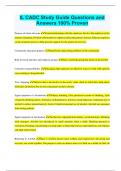IL CADC Study Guide Questions and Answers 100% Proven Purpose of client advocate ✔✔Formal relationship with the employer, Involve the employer in the patient's treatment, Promote information to employer about the patient's disease, Educate employer on the treatment process, Help provide support for the patien t in recovery Community education purpose ✔✔Identify the major drug problems in the community Role for local churches and religious groups ✔✔Start a self -help group that meets in the facility Counselor responsibilities ✔✔Educating other agencies on effe ctive ways to work with specific cases relating to drugs/alcohol Two- Stepping ✔✔Defense that is destructive to the newly sober client in which they help others with their alcoholism but do not concentrate on their sobriety Signs/symptoms of Alcoholism ✔✔Solitary drinking, Over permissive norms of drinking, Lack of specific drinking norms, Tolerance of drunkenness, Adverse social behaviors, Utilitarian use of alcohol to reduce tension/anxiety, Lack of ritual/ceremonial use of alcohol, Alcohol use separate d from eating patterns Signs/symptoms of Alcoholism ✔✔Alcohol use separated from family, social functions, Drinking with strangers, Alcohol not introduced in small amounts when a child, Drinking pursued as recreation, Drinking concentrated in young males, Culture that stresses individualism, self -reliance and high achievement Referring to AA/NA ✔✔Have a AA/NA person meet w/them and explain how the group and recovery can work together, Not proper to refer an atheist since it is built on a belief in God, do not refer if it would seem to be disrespectful of clients rights and views, Make sure the referral meets the clients personality and background Dual Diagnosis ✔✔Sometimes appear as patients sober up Referral processes ✔✔Identifying the needs of the clie nt that cannot be met by the counselor/agency and Assisting the client to utilize the support system and community resources available Discharge summary is needed ✔✔Inpatient, aftercare, detox, half way houses, etc, Communications from one agency to anoth er and increases accountability, Reports and record keeping tells the story of the client from beginning to end, No universally accepted format for maintaining records Reports ✔✔Explains various aspects of the assessment, treatment plans, and discharge to parties who need such information to enhance the care of the client Documents patient can sign ✔✔Consent for treatment, Public aid, DASA, statistics, Treatment plans, Release of information, To acquire medical attention, Education/prevention, Client educ ation, Crisis intervention Patient has a right to ✔✔Treatment costs they are liable for, When treatment services are available, Types of counseling approaches used, Opportunity to complain to appropriate staff Client files ✔✔Only the clinical supervisor has unrestricted access to client's files Physiological dependence for alcohol - Alpha ✔✔Psychological dependence, no loss of control, reliance on alcohol to weather problems Physiological dependence for alcohol - Beta ✔✔Psychological dependence, physical problems (cirrhosis) but no physical dependence Physiological dependence for alcohol - Gamma ✔✔Change in tolerance, physical withdrawal, loss of control. Use for Jellinek Chart with 4 stages Physiological depen dence for alcohol - Delta ✔✔Same as Gamma but no loss of control but drinks Physiological dependence for alcohol - Epsilon ✔✔Periodic alcoholism/binge drinking Aversive therapy ✔✔Disulfiram/Antibuse - Most effect for binge drinkers and No alcohol for 2 weeks or severe allergy reactions occur Direct Reinforcement ✔✔Providing positive feedback and rewarding in a direct way and Introducing new and competing behaviors to replace negative behaviors Analytic therapy ✔✔Oriented toward achieving insight, identi fying and experiencing feelings, memories developing, in -depth self -understanding, re -experiencing, reconstructing childhood experience, Not appropriate for first month of counseling Erickson's Psychological Theory ✔✔Trust vs Mistrust; Autonomy vs Doubt; Initiative vs Guilt; Industry vs Inferiority; Identity vs Role Diffusion - Adolescent; Intimacy vs Isolation - Adult; Generativity vs Stagnation - Adult; Integrity vs Despair - Old age Social Learning ✔✔Behavior learned through interaction with other peop le, peer group, AA group, group therapy Cognitive Restructuring ✔✔Positive affirmations spoken to self to modify negative thoughts Reality Therapy/Transactional Therapy (Glasser 1960s) ✔✔What is going on "here and now", How a client can change old patter ns, Client makes decisions based on awareness Maslow - Self-actualization ✔✔Teaches person to challenge old ideas and replace/internalize logic or science Gestalt Therapy ✔✔Increase awareness of feelings, Persons are born innately good, Focuses on unfinished business, Focus on "what and how" and not "why". Client's are to be aware of what they are doing, how they are doing it and the gaining of self -esteem. No diagnosis or interpretation Carl Rogers ✔✔Persons need self -fulfillment rather than being occupied with others Relaxation Therapy ✔✔If body and breathing are relaxed it is impossible to feel anxious, Tensing and then relaxing muscles Systematic Desen sitization ✔✔Used w/relaxation for treating phobias Adlerian Therapy ✔✔Concept of inferiority complex, Encouragement to recognize strengths and weaknesses, Believes in dignity and self -worth, Mainly used in family counseling Client Centered "Rogerian The rapy" ✔✔Based on assumption that the client is in the best position to resolve their own problems, Safe atmosphere to feel/discuss and obtain insight is provided Jungian Therapy ✔✔Developed the concept of collective unconscious and archetypes, Goal is to have clients become adequately adopted to reality allowing them to fulfill their creative potential, Individuation is the ultimate goal Vernon Johnson's Therapy ✔✔Learning theory; Individual learns that drinking is a successful way to deal w/problems, Fam ily, etc in the addict's life reinforces this by their behaviors which enables




